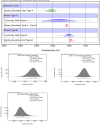From rammed earth to stone wall: Chronological insight into the settlement change of the Lower Xiajiadian culture
- PMID: 35994457
- PMCID: PMC9394813
- DOI: 10.1371/journal.pone.0273161
From rammed earth to stone wall: Chronological insight into the settlement change of the Lower Xiajiadian culture
Abstract
In this article, we investigate the chronological change of settlements of the Lower Xiajiadian (LXJD) culture in northeast China. On the basis of excavation data, two types of settlements can be identified based on the methods of site construction: earthen (rammed earth/mudbrick) settlements and stone-constructed settlements. After integrating and reanalyzing all published 14C radiocarbon data of different LXJD sites, we argue that there is a clear chronological difference between these two types of settlements. It is revealed by the OxCal model that settlements built with earthen structures are generally earlier than those constructed with stones, and the changes in settlement spatial distribution and constructive material largely happened after 1500 BC. By means of correlation analysis with other related archaeological evidence, we suggest that the underlying social dynamics that contributed to LXJD settlement changes can be explored through multiple prospects.
Conflict of interest statement
The authors have declared that no competing interests exist.
Figures





References
-
- Guo DS. Lower Xiajiadian Culture. In: Nelson SM, editor. The archaeology of northeast China: Beyond the Great Wall. London: Routledge; 1995. pp. 147–181.
-
- Shelach-Lavi G. Leadership Strategies, Economic Activity, and Interregional Interaction. Fundamental Issues in Archaeology. New York: Kluwer Academic/Plenum; 1999.
-
- Weneuju Guojia. Zhongguo Wenwu Dituji: Shanxi Fence (Atlas of Chinese Cultural Relics: The Volume of Shanxi). Beijing: Cultural Relics Publishing House; 2003. In Chinese.
-
- Wenwuju Guojia. Zhongguo Wenwu Dituji: Liaoning Fence (Atlas of Chinese Cultural Relics: The Volume of Liaoning). Beijing: Cultural Relics Publishing House); 2009. In Chinese.
-
- Chifeng International Collaborative Archaeological Research Project. Settlement Patterns in the Chifeng Region. Pittsburgh: Center for Comparative Archaeology; 2011.
MeSH terms
LinkOut - more resources
Full Text Sources

